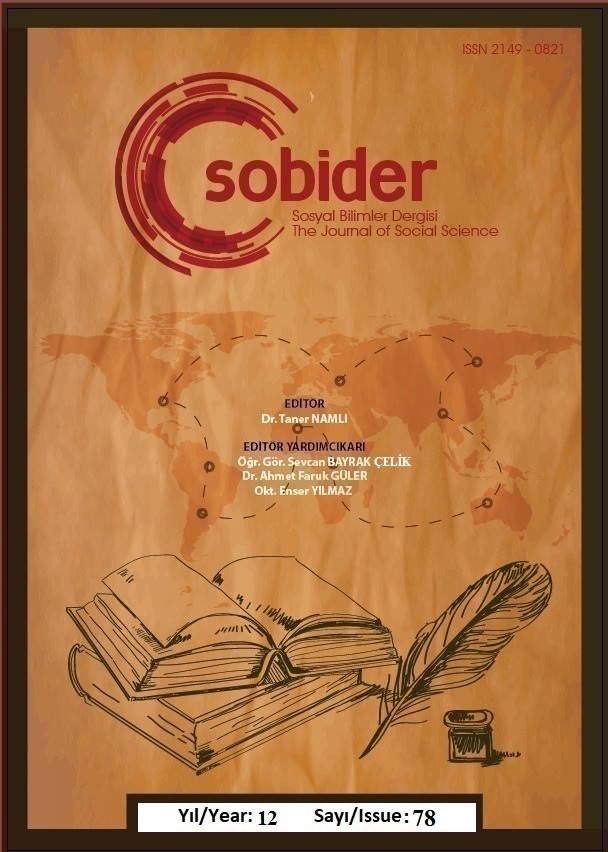Author :
Abstract
Postdijital çağ, dijital teknolojilerin gündelik yaşamın kaçınılmaz bir gerçekliği haline geldiğini kabul etmekle birlikte, kaçınılmaz olarak bu hâkimiyetin sorgulanmasına imkân tanıyan eleştirel ve alternatif düşünce biçimlerini de içermektedir. Bu makale, postdijital kavram çerçevesinde sözsüz kitaplarda analog kitap resimleme pratiklerinin estetik ve eleştirel potansiyelini incelemektedir. Çalışma, elle çizim, suluboya, karakalem, pastel ve gravür gibi analog tekniklerin, dijital üretimlerin hız, homojenlik ve yüzeysel estetik anlayışına karşı; daha derinlikli, duygusal yoğunluğu yüksek ve otantik bir ifade biçimi olarak yeniden önem kazandığı vurgulanmaktadır. Sözsüz kitaplarda metnin olmayışı, görselin özerkliğini güçlendirirken, çizginin kişisel izleri ve malzemenin dokusallığı aracılığıyla okura eleştirel bir katılım alanı açmaktadır. Walter Benjamin’in “auranın kaybı” kavramı üzerinden tartışılan bu durum, görsellerin tekilliğini ve özgünlüğünü yeniden görünür kılmaktadır. Umberto Eco’nun “açık yapıt” yaklaşımı ve W.J.T. Mitchell’in görselin söylemsel gücüne ilişkin görüşleri, sözsüz kitapların okuma deneyimleri sunma kapasitesiyle ilişkilendirilmiştir. Shaun Tan, Aaron Becker, David Wiesner ve Suzy Lee’nin eserleri incelenmiş; bu eserlerde görselin pedagojik, estetik ve kültürel boyutları irdelenmiştir. Sözsüz kitaplarda analog üretim teknikleri dijital çağın hız ve yüzeysellik kültürüne karşı estetik ve eleştirel bir direniş alanı olarak değerlendirilmiştir. Türkiye’de sözsüz kitap üretimleri uluslararası eğilimlerle karşılaştırıldığında henüz sınırlı bir düzeydedir ve gelişime açık bir alandır.
Keywords
Abstract
Abstract
The postdigital era acknowledges that digital technologies have become an inescapable reality of everyday life, while simultaneously allowing for the emergence of critical and alternative modes of thought that question this dominance. This article examines the aesthetic and critical potential of analog illustration practices in wordless picturebooks within the framework of the postdigital concept. The study emphasizes that analog techniques such as hand drawing, watercolor, pencil, pastel, and engraving have regained significance as deeper, emotionally richer, and more authentic forms of expression against the speed, homogeneity, and superficial aesthetics of digital production. In wordless picturebooks, the absence of text strengthens the autonomy of the visual, opening a space of critical engagement for the reader through the personal traces of the line and the materiality of texture. Discussed in relation to Walter Benjamin’s notion of the “loss of aura,” this condition renders the uniqueness and originality of images newly visible. Umberto Eco’s concept of the “open work” and W.J.T. Mitchell’s insights into the discursive power of the visual are connected to the capacity of wordless books to generate diverse reading experiences. Works by Shaun Tan, Aaron Becker, David Wiesner, and Suzy Lee are examined, with particular attention to their pedagogical, aesthetic, and cultural dimensions. Analog production techniques in wordless picturebooks are thus interpreted as a site of aesthetic and critical resistance to the culture of speed and superficiality in the digital age. In Turkey, the production of wordless picturebooks remains limited compared to international trends and represents a field open to further development.





